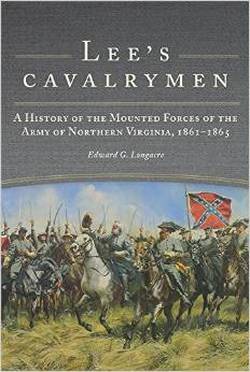
Edward G. Longacre
The University of Oklahoma Press, 2012 paperback, 468 pp. + 14 pp. introduction, $21.95
ISBN: 978-0-8061-4230-2
image courtesy of amazon.com
Lee’s Cavalrymen is the companion volume to Lincoln’s Cavalrymen as a study into the branch of the Army of Northern Virginia. In this text, there is the usual history of the cavalry during the war, but the study goes even farther than others do. Longacre gives us a look into the life of the cavalryman during battle and during the downtime of the action. While other books about the cavalry of the Army of Northern Virginia tend to deal with the actions of General Stuart, this book looks into all of the men who were important in the realm of the cavalry for the eastern theater of the war. Finally in paperback, this book has been a classic and standby for cavalry studies for years now.
Edward G. Longacre is the author of many books on the Civil War and some of his works have become the standalone studies of their subject. The Cavalry at Gettysburg is still the standard reading for students who wish to know more about the campaign and the role which the cavalry took part in. He is also the author of the new work on the Battle of Manassas, The Early Morning of War which is the best book written on the campaign which started the war. Along with Lee’s Cavalrymen, Longacre also wrote Lincoln’s Cavalrymen as a companion book to this one on Union cavalry. He is also the winner of the Douglas Southall Freeman History Award for his book Gentleman and Soldier: A Biography of Wade Hampton III.
Much like Lincoln’s Cavalrymen, this book begins not by just jumping into the history of the cavalry division of the Army of Northern Virginia, but by explaining how they were organized and the roles the commanders played in the outset of the war. As I read through the opening chapters, I began to discover that the cavalry in the Confederate army was much more trained and ready than those in the Union. There was the preparedness for many of them since those who enlisted already had training with horses. As it was with Lincoln’s Cavalrymen, the section which Longacre wrote about the Battle of Brandy Station was well done and is, usually, a battle not entirely looked at for the largest cavalry battle on the Western Hemisphere. Many readers will flock to the section on Gettysburg to get an idea on what Longacre’s opinion is on Stuart’s actions. Without ruining anything, I will not mention the details. Throughout the text, the detail in the research is second to none and Longacre should be praised for writing an account of the Army of Northern Virginia’s cavalry in such a fine manner. Aided with maps and pictures, there is little to wonder about what the author is talking about and gives more depth into the world of what the cavalry was like.
I highly recommend this book to anyone interested in cavalry history of the Civil War. Much like Lincoln’s Cavalrymen, this should be the companion volume to that set. The ease of the narrative makes this book easily accessible to anyone who has either been in the study for a long time or someone new to the Civil War. I praise Longacre’s work for what he has done with the cavalry and hope this book continues to be used as one of the great standards of Civil War studies.
 RSS Feed
RSS Feed
